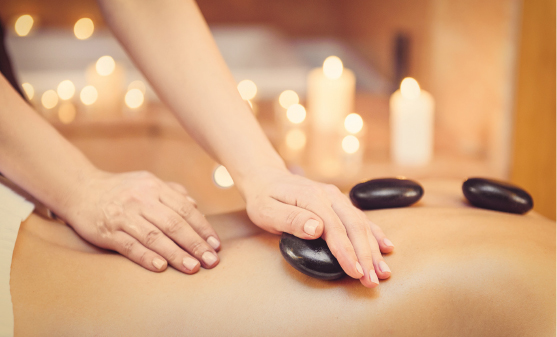The ASCO Post’s Integrative Oncology series is intended to facilitate the availability of evidence-based information on integrative and complementary therapies commonly used by patients with cancer. In this installment, Ting Bao, MD, DABMA, MS, reviews the current data on the use of massage to reduce cancer-related fatigue, pain, mood disturbance, sleep disturbance, and lymphedema as well as explores some of the challenges associated with this modality.

Ting Bao, MD, DABMA, MS
Dr. Bao is Director, Integrative Breast Oncology, Integrative & Breast Medicine Services, Memorial Sloan Kettering Cancer Center, New York.
Massage therapy is among the integrative modalities that play an important role in cancer supportive care. Both the National Comprehensive Cancer Network (NCCN) Clinical Practice Guidelines in Oncology (NCCN Guidelines®) and Clinical Practice Guidelines on the Use of Integrative Therapies recommend massage to reduce cancer-related fatigue, pain, mood disturbance, and lymphedema.1,2 This article examines the current evidence for clinical effectiveness of massage therapy to relieve symptoms and improve pain and sleep profiles across the cancer care continuum.
Current Evidence
A 2016 SYSTEMATIC review and meta-analysis of 16 randomized controlled trials showed that massage therapy was effective for treating pain, fatigue, and anxiety.3 A large study at Memorial Sloan Kettering Cancer Center (MSK; N = 1,290) demonstrated the feasibility and efficacy of massage therapy, with an approximate 50% reduction in distress symptoms, even among patients with high baseline scores.4
More recently, evaluation of the immediate impact of massage treatments provided in MSK chemotherapy-infusion suites found significantly decreased anxiety, fatigue, pain, and nausea (all P < .001) among 692 participants.5 A total of 93% of patients were satisfied, and 94% would recommend massage therapy to others undergoing treatment. A randomized controlled trial of bone marrow transplant patients (N = 88) also confirmed that massage during active treatment significantly reduced neurologic complications and improved perceived benefits of therapy.6
Massage treatments may also produce longer-term effects. In a randomized controlled trial of Swedish massage in 86 patients with breast cancer, significant reductions in physical discomfort occurred both at intervention end (week 5, P = .001) and at week 11 (P = .038) vs routine health-care controls.7 However, significant reductions in mood disturbance achieved by week 5 (P < .01) dissipated at week 11 follow-up. Of note, continuous treatment with the same therapist significantly contributed to improved mood.
Massage also has shown benefits in advanced cancer populations. In a randomized controlled trial of reflexology, a specialized type of foot massage, among 385 patients with advanced breast cancer receiving chemotherapy and/or hormonal therapy, physical functioning and dyspnea severity were significantly improved vs standard care (P =.04 and < .01, respectively), although no differences were found for depression, anxiety, pain, or nausea.8 In addition, participants receiving a foot massage by a provider not trained or licensed in massage therapy had significant improvements in fatigue (P < .01) but not in physical functioning. In a palliative care setting of 42 patients with advanced cancers, massage significantly improved sleep and depression but not pain or anxiety.9 Subgroup analyses further identified those with high psychological distress levels as being more likely to respond to treatment.

Therapeutic results also may be achieved in specific subpopulations or with certain types of massage. For example, gentle abdominal massage improved depression, anxiety, well-being, and perceived abdominal bloating in patients with malignant ascites.10 Other preliminary studies suggest improvements with massage in cancer treatment– related nausea.11-13 Manual lymphatic drainage, a commonly used skin-surface-only technique,14 was shown to reduce lymphedema15 and prevent secondary lymphedema16 in patients with breast cancer. Hospitalized adolescents may also benefit from massage therapy, with trends toward increased nighttime and overall sleep.17 Among cancer-family caregivers, massage improved sleep quality, anxiety, cortisol levels, blood pressure, and pulse rate.18
Utilization and Safety Concerns
MASSAGE IS GENERALLY safe, even during active treatment,5,6 to help address fatigue, anxiety, pain, and sleep problems, when provided by a qualified massage therapist (Society for Oncology Massage [http://www.s4om.org/]). However, a patient-centered approach optimizes the effects of integrative therapies, and massage is no exception. Our recent data showed that although a majority (63%) of 1,090 massage sessions offered in our chemotherapy-infusion suites were accepted, about one-third declined, with time concerns or lack of interest mainly cited as reasons for nonparticipation.5 Patients also may not be amenable to, or may have negative associations with, touch. Therefore, it is important to determine whether massage as a support modality would be well received or whether another type of integrative therapy may be more appropriate to help address symptoms.
Local massage, such as reflexology on the hands, feet, or ears, is particularly useful in instances where massage would otherwise be avoided, such as due to anatomic sites of tumor involvement, suspected obstructions, areas of recent radiotherapy or surgery, or near locations where devices are implanted to deliver chemotherapy or assist in wound healing. Even among a large sample of patients with advanced-stage breast cancer, reflexology was shown to be safe, with routine precautions taken for open sores and painful foot neuropathy.8
In clinic and hospital settings, massage therapy may enhance the perceived benefits of cancer treatment6 and address the barriers of time, cost, travel, and space issues that typically hinder its utilization.5 It is also an ideal modality for weak and elderly patients to induce relaxation and improve sleep9 and can be safely administered in a trained-caregiver capacity.8,19
Challenges and Future Directions
ONE MAJOR CONCERN about massage therapy is that it may confer only short-term benefits. Large sample-sized massage therapy clinical trials with long-term follow-up are needed. In addition, how best to standardize massage interventions during clinical trials remains to be answered. Massage therapy in a clinical setting, particularly within an oncology context, is a nuanced intervention utilizing multiple modalities and adaptations based on the patient’s individual needs. As such, it is not easily standardized for the purposes of a randomized controlled trial, nor is it easily blinded. These types of challenges may contribute to negative results. In addition, the mechanism of how massage therapy works should be investigated further.
Pilot studies have begun to evaluate potential mechanisms such as immune response,20,21 but more study in this area is needed. Sidestream or downstream benefits might also be explored. For example, improvements in breathing induced by massage may lead to a willingness to be more active.8 Overarching areas of interest include more diverse enrollment of study participants, how massage may improve cancer treatment experiences and adherence, and evaluation of improved models of efficient massage care delivery. ■
Acknowledgment: Dr. Bao would like to thank Ingrid Haviland, Assistant Editor at the Memorial Sloan Kettering Cancer Center’s Integrative Medicine Service, for her writing and editorial assistance.
DISCLOSURE: Dr. Bao reported no conflicts of interest.
REFERENCES
1. National Comprehensive Cancer Network (NCCN): 2018 NCCN Clinical Practice Guidelines in Oncology, Supportive Care: Cancer-Related Fatigue. version 2.2018. Available at https://www.nccn.org/professionals/physician_gls/pdf/fatigue.pdf. Accessed March 29, 2018.
2. Greenlee H, Balneaves LG, Carlson LE, et al: Clinical practice guidelines on the use of integrative therapies as supportive care in patients treated for breast cancer. J Natl Cancer Inst Monogr 2014;346-358, 2014.
3. Boyd C, Crawford C, Paat CF, et al: The impact of massage therapy on function in pain populations—A systematic review and meta-analysis of randomized controlled trials: Part II, Cancer pain populations. Pain Med 17:1553-1568, 2016.
4. Cassileth BR, Vickers AJ: Massage therapy for symptom control: Outcome study at a major cancer center. J Pain Symptom Manage 28:244-249, 2004.
5. Mao JJ, Wagner KE, Seluzicki CM, et al: Integrating oncology massage into chemoinfusion suites: A program evaluation. J Oncol Pract 13:e207-e216, 2017.
6. Smith MC, Reeder F, Daniel L, et al: Outcomes of touch therapies during bone marrow transplant. Altern Ther Health Med 9:40-49, 2003.
7. Listing M, Reisshauer A, Krohn M, et al: Massage therapy reduces physical discomfort and improves mood disturbances in women with breast cancer. Psychooncology 18:1290-1299, 2009.
8. Wyatt G, Sikorskii A, Rahbar MH, et al: Health-related quality-of-life outcomes: A reflexology trial with patients with advanced-stage breast cancer. Oncol Nurs Forum 39:568-577, 2012.
9. Soden K, Vincent K, Craske S, et al: A randomized controlled trial of aromatherapy massage in a hospice setting. Palliat Med 18:87-92, 2004.
10. Wang TJ, Wang HM, Yang TS, et al: The effect of abdominal massage in reducing malignant ascites symptoms. Res Nurs Health 38:51-59, 2015.
11. Robison JG, Smith CL: Therapeutic massage during chemotherapy and/or biotherapy infusions: Patient perceptions of pain, fatigue, nausea, anxiety, and satisfaction. Clin J Oncol Nurs 20:E34-E40, 2016.
12. Mazlum S, Chaharsoughi NT, Banihashem A, et al: The effect of massage therapy on chemotherapy-induced nausea and vomiting in pediatric cancer. Iran J Nurs Midwifery Res 18:280-284, 2013.
13. Zorba P, Ozdemir L: The preliminary effects of massage and inhalation aromatherapy on chemotherapy-induced acute nausea and vomiting: A quasi-randomized controlled pilot trial. Cancer Nurs. April 20, 2017 (early release online).
14. Donahue PM, Crescenzi R, Scott AO, et al: Bilateral changes in deep tissue environment after manual lymphatic drainage in patients with breast cancer treatment-related lymphedema. Lymphat Res Biol 15:45-56, 2017.
15. Williams AF, Vadgama A, Franks PJ, et al: A randomized controlled crossover study of manual lymphatic drainage therapy in women with breast cancer-related lymphoedema. Eur J Cancer Care (Engl) 11:254-261, 2002.
16. Torres Lacomba M, Yuste Sánchez MJ, Zapico Goni A, et al: Effectiveness of early physiotherapy to prevent lymphoedema after surgery for breast cancer: Randomised, single blinded, clinical trial. BMJ 340:b5396, 2010.
17. Jacobs S, Mowbray C, Cates LM, et al: Pilot study of massage to improve sleep and fatigue in hospitalized adolescents with cancer. Pediatr Blood Cancer 63:880-886, 2016.
18. Pinar R, Afsar F: Back massage to decrease state anxiety, cortisol level, blood prsessure, heart rate and increase sleep quality in family caregivers of patients with cancer: A randomised controlled trial. Asian Pac J Cancer Prev 16:8127- 8133, 2015.
19. Stephenson NL, Swanson M, Dalton J, et al: Partner-delivered reflexology: Effects on cancer pain and anxiety. Oncol Nurs Forum 34:127-132, 2007.
20. Krohn M, Listing M, Tjahjono G, et al: Depression, mood, stress, and Th1/Th2 immune balance in primary breast cancer patients undergoing classical massage therapy. Support Care Cancer 19:1303-1311, 2011.
21. Noto Y, Kitajima M, Kudo M, et al: Leg massage therapy promotes psychological relaxation and reinforces the first-line host defense in cancer patients. J Anesth 24:827-831, 2010.

